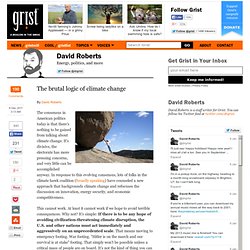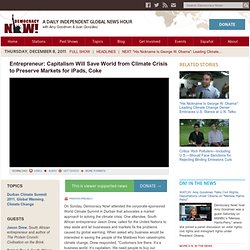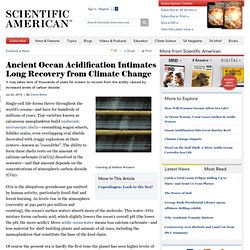

World headed for irreversible climate change in five years, IEA warns. The world is likely to build so many fossil-fuelled power stations, energy-guzzling factories and inefficient buildings in the next five years that it will become impossible to hold global warming to safe levels, and the last chance of combating dangerous climate change will be "lost for ever", according to the most thorough analysis yet of world energy infrastructure.

The brutal logic of climate change. The consensus in American politics today is that there’s nothing to be gained from talking about climate change.

It’s divisive, the electorate has more pressing concerns, and very little can be accomplished anyway. In response to this evolving consensus, lots of folks in the climate hawk coalition (broadly speaking) have counseled a new approach that backgrounds climate change and refocuses the discussion on innovation, energy security, and economic competitiveness. This cannot work. At least it cannot work if we hope to avoid terrible consequences. Why not? It is unpleasant to talk like this. So let’s have some real talk on climate change. Let’s walk through Anderson’s logic. 1. The 2 degrees C number has been around for over a decade and was reaffirmed by the Copenhagen Accord just last year. Here’s a chart attempting to show, in simplified form, what amount of temperature rise will produce dangerous effects (the red zones) and what the 2 degrees C level means: Click for larger version.
Arctic sea ice volume: The death spiral continues. By Joe Romm on May 19, 2011 at 5:00 pm "Arctic sea ice volume: The death spiral continues"

Entrepreneur: Capitalism Will Save World from Climate Crisis to Preserve Markets for iPads, Coke. On Sunday, Democracy Now!

Attended the corporate-sponsored World Climate Summit in Durban that advocates a market approach to solving the climate crisis. One attendee, South African entrepreneur Jason Drew, called for the United Nations to step aside and let businesses and markets fix the problems caused by global warming. When asked why business would be interested in saving the people of the Maldives from catastrophic climate change, Drew responded, "Customers live there. It’s a business world. It’s capitalism. This is a rush transcript. AMY GOODMAN: We’re broadcasting live throughout this week, ending tomorrow, here in Durban, South Africa, where the COP 17 is having its meeting, the Conference of Parties, the U.N. On Sunday, Democracy Now! JASON DREW: We’re here talking about COP 17. MIKE BURKE: I’m curious how you would describe this or, you know, make this argument to someone, say, from the Maldives or one of the small island nations.
JASON DREW: Consumers live there. "Get It Done": Urging Climate Justice, Youth Delegate Anjali Appadurai Mic Checks U.N. Summit. A number of protests are being held today at the United Nations Climate Change Conference in Durban to protest the failure of world leaders to agree to immediately agree to a deal of binding emissions cuts.

Lauding "Collapse of Global Warming Movement," Sen. Inhofe Tells U.N. Summit "You Are Being Ignored" While no members of the U.S.

Congress attended the United Nations Climate Change Conference in Durban, Republican Senator James Inhofe of Oklahoma recorded a video message that was aired at a press conference of climate change deniers here at the summit on Wednesday. "Tossing out any remote possibility of a U.N. global warming treaty is one of the most important things we can do for the economy," Sen. Inhofe said. "I’m making this announcement from Washington, D.C., where I am confident that the only person left talking about global warming is me. Clathrate gun hypothesis. The blue graph shows the apparent percentage (not the absolute number) of marine animalgenera becoming extinct during any given time interval.

It does not represent all marine species, just those that are readily fossilized. The labels of the "Big Five" extinction events are clickable hyperlinks; see Extinction event for more details. (source and image info) The clathrate gun hypothesis is the popular name given to the hypothesis that rises in sea temperatures (and/or falls in sea level) can trigger the sudden release of methane from methane clathrate compounds buried in seabeds and permafrost which, because the methane itself is a powerful greenhouse gas, leads to further temperature rise and further methane clathrate destabilization – in effect initiating a runaway process as irreversible, once started, as the firing of a gun.[1] Mechanism[edit] Ancient Ocean Acidification Intimates Long Recovery from Climate Change. Single-cell life-forms thrive throughout the world's oceans—and have for hundreds of millions of years.

Tiny varieties known as calcareous nanoplankton build exuberant, microscopic shells—resembling wagon wheels, fishlike scales, even overlapping oval shields decorated with craggy explosions at their centers—known as "coccoliths". The ability to form these shells rests on the amount of calcium carbonate (CaCO3) dissolved in the seawater—and that amount depends on the concentrations of atmospheric carbon dioxide (CO2). CO2 is the ubiquitous greenhouse gas emitted by human activity, particularly fossil-fuel and forest burning.